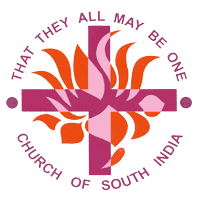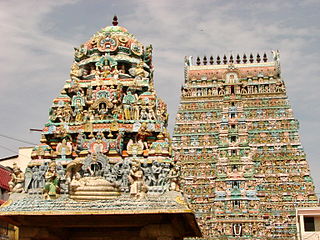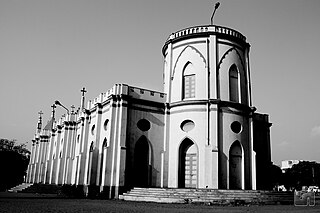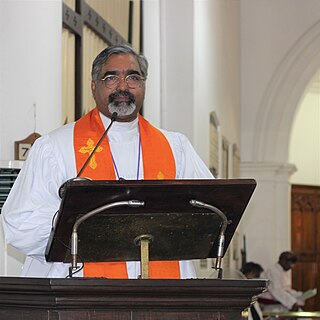
The Church of South India (CSI) is a united Protestant Church in India. It is the result of union of a number of Protestant denominations in South India that occurred after the independence of India.

Madras Medical College (MMC) is a public medical college located in Chennai, Tamil Nadu, India. Established in 1835, it is one of the oldest medical colleges in India, as well as in Asia.
Egmore is a neighbourhood of Chennai, India. Situated on the northern banks of the Coovum River, Egmore is an important residential area as well as a commercial and transportation hub. The Egmore Railway Station was the main terminus of the Madras and Southern Mahratta Railway and later, the metre gauge section of the Southern division of the Indian Railways. It continues to be an important railway junction. The Government Museum, Chennai is also situated in Egmore. Other important institutions based in Egmore include the Government Women and Children's Hospital, the Tamil Nadu State Archives and the Tamil Nadu Archaeology Department. The Wesley Church, Egmore is the oldest church of the region.
The Egmore Eye Hospital, officially the Regional Institute of Ophthalmology and Government Ophthalmic Hospital, is a public eye hospital in Chennai, India. Considered the oldest eye hospital in Asia, the institute was established in 1819 and is the second oldest hospital of its kind, next only to the Moorfields Eye Hospital in the United Kingdom.

The Sarangapani Temple is a Hindu temple dedicated to Vishnu, located in Kumbakonam, Tamil Nadu, India. It is one of the Divya Desams, the 108 temples of Vishnu revered in Nalayira Divya Prabandham by the 12 poet saints, or Alvars. This temple is along Kaveri and is one of the Pancharanga Kshetrams.

The Diocese of Medak is one of the prominent Dioceses in the Church of South India, a Protestant Uniting Church with its headquarters in Medak comprising nearly 200 Presbyters ministering to Telugu, Lambadi, Tamil, Kannada, Malayalam, Hindustani, English and other linguistic groups numbering nearly 1/3rds of a million spread over 105 pastorates and administered through 3 District Church Councils (DCC), namely, the Town DCC, the Medak DCC and the Godavari DCC geographically located in the erstwhile civil districts of Adilabad, Nizamabad, Medak, Rangareddy, Hyderabad and Mahboobnagar in Telangana.
Handel Manuel was an Indian pianist, organist, conductor, composer and accompanist. He helped to make western classical music popular in Chennai, the capital of the Indian state of Tamil Nadu.

Peter Percival was a British born missionary and educator who opened religious schools in Sri Lanka and South India during the British colonial era.) During his stay in Jaffna, he led the effort to translate the Authorized King James Version of Bible into the Tamil language, working with the Tamil scholar Arumuka Navalar – a Shaiva Hindu. Percival's work influenced Robert Bruce Foote. Percival began his career in British held Sri Lanka and Bengal as a Wesleyan Methodist missionary. He was instrumental in starting and upgrading a number of Christian schools within the Jaffna peninsula. After returning to England, he converted to Anglicanism. Subsequent to his posting in South India, he severed his association with the Anglican Missionary Society that had sent him to India and worked as an educator in Presidency College in Madras Presidency. He published English-Tamil and English-Telugu dictionaries as well as a number of books on Indian culture and religion. He died in 1882 in Yercaud in present-day Tamil Nadu.
Rev. John Breeden was an English Wesleyan Methodist Missionary Society missionary in the Madras Presidency. He was an educationalist and the founder of St George's Homes, an orphanage-cum-school for abandoned and deprived children of Eurasians or Anglo-Indians in Kodaikanal, later renamed as The Laidlaw Memorial School, Ketti in the Nilgiris.
The Karnataka Central Diocese is one of the twenty-two dioceses of the Church of South India covering the central part of Karnataka.
Cox Town, Bengaluru is a neighborhood of the Bangalore Cantonment, located in the central part of the city and named after the last Collector and District Magistrate of the Bangalore Civil and Military Station, Alexander Ranken Cox, Indian Civil Services. It is one of the suburbs which came out of the plan to de-congest thickly populated areas of the Bangalore Cantonment after the bubonic plague. Agricultural fields were converted for this purpose, and town was planned according to modern hygienic standards, with drainage and conservancy conveniences. Sarvagnanagara is bound by the Bangalore-Madras Railway line on the North and East, Wheeler Road in the East and the Ulsoor Polo Ground in the South. It consists of posh localities like Heerachand Layout and other localities like Sindhi Colony, Jeevanahalli, Doddigunta, and roads such as Assaye Road, Charles Campbell Road, Wheeler Road, etc. and is adjoining the suburbs of Pulakeshi Nagara, Sri Krishnaraja Wadiyar Nagara and Cooke Town, with easy access to the Bengaluru East Railway Station, Halasuru, Lingarajapura, Shivajinagara. Sarvagnanagara is a well planned, posh and preferred locality in the Bangalore Cantonment, created during the British Raj. The residents of Sarvagnanagara follow a liberal 'live a let live' attitude, with suburb still retaining much of its green cover, without excessive commercialisation. In 1988, the BBMP renamed Cox Town as Sarvagnanagara, after a 16th-century saint poet.

Adi Kesava Temple is dedicated to Hindu god Vishnu located in Mylapore, Chennai, in the South Indian state of Tamil Nadu. Constructed in the Tamil style of architecture, dedicated to Vishnu, who is worshipped as Adi Kesava Perumal and his consort Lakshmi as Mayuravalli Thayar. The temple is believed to be the birthplace of Peyalvar, an Alvar saint. It is considered one among the 108 Abhimana Kshethram of Vaishnavate tradition.

Thomas Hodson was a Wesleyan Missionary, who served in India, in the Wesleyan Canarese Mission, at the Bangalore Petah and Gubbi. He helped in running the first Wesleyan Mission Canarese school in the erstwhile Mysore State. Hodson was a linguist and a Kannada scholar, and was also fluent in Tamil and Bengali. He helped in establishing the Wesleyan Canarese Chapel at Nagarthpete in the Bangalore Petah. In 1864, Hodson wrote An Elementary Grammar of the Kannada, or Canarese Language, a treatise on the grammar of the Kannada language.

St. Peter's Church is one of the oldest churches in Royapuram area of Chennai, the capital of the South Indian state of Tamil Nadu. The original structure was built in Gothic architecture in 1829 by Gurukula Vamsha Varnakula Mudaliars, a group of boatmen who were serving the East India Company. They started building the church in 1825 and consecrated it in 1829 with contributions from the Secretary of Marine Board.

Anderson Church is one of the oldest churches in Parry's Corner area of Chennai, the capital of the South Indian state of Tamil Nadu. The original structure was built in 1845 by Anderson as an educational institution. The church is named after Anderson, a Scottish missionary who founded the mission of the Free Church of Scotland at Madras, India.
The United Mission School is located on Mission Road, Bangalore and is managed by the Church of South India. The school offers English medium education and is affiliated to the Karnataka Secondary Education Examination Board. The school has classes from Year 1 to Year 10. In 1993, the United Mission Degree College was established on the same campus, offering Bachelor of Commerce and Bachelor of Business Management courses, affiliated to the Bangalore University.

A. C. Solomon Raj is the seventh successor of Frank Whittaker and eighth Bishop in Medak of the Protestant Church of South India Society and shepherds the Diocese from the Cathedra of the Bishop housed in the CSI-Medak Cathedral in Medak Town, Telangana, India. On 12 October 2016, the Church of South India Synod headquartered in Chennai, appointed Solomon Raj to assume the ecclesiastical Office of the Bishopric of Medak and was consecrated the next day on 13 October 2016 at the CSI-St. George's Cathedral, Chennai, ending four years of sede vacante in the Diocese of Medak which was without a bishop during the intervening period of 2012–2016.
CSI-Garrison Wesley Church located in Trimulgherry is among the oldest churches in Secunderabad under the auspices of the Protestant Church of South India (CSI) within the ecclesiastical jurisdiction of the Diocese of Medak. Situated in Lal Bazar civilian area of the Secunderabad Cantonment, the CSI-Garrison Wesley Church is in near vicinity of the Military College of Electronics and Mechanical Engineering (MCEME), and the church has continued to attract not only its regular worshipers but also the new visitors from the nearby military stations of the Indian Army and the Indian Air Force through its regular Sunday Mass as well as its annual Good Friday, Easter and Christmas programmes.
Zion Church is one of the oldest churches in Chintadripet area of Chennai, the capital of the South Indian state of Tamil Nadu. The original structure was built in Gothic architecture in 1847 by US missionaries. The church is the oldest church built by US missionaries in Chennai. The church also has the second oldest bell in the city.

Royapettah is a neighbourhood of Chennai, India.
















